IGEL Co-CEO Jed Ayres’ Five Boldest Statements From DISRUPT 2020
IGEL Co-CEO Jed Ayres says he has set a goal for the company to break the $1 billion sales barrier as it moves to capture the exploding cloud workspaces opportunity with its IGEL next generation edge operating system.
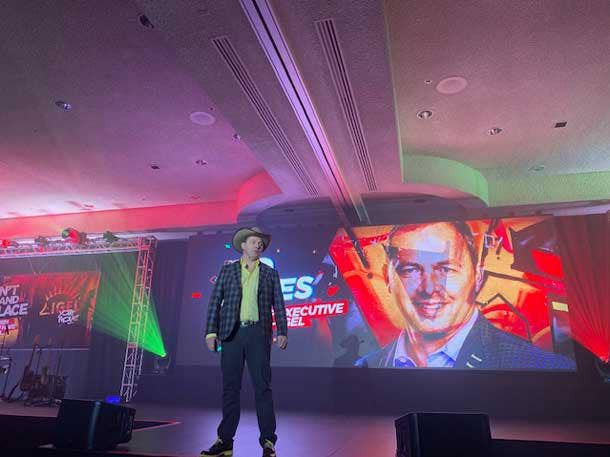
A Billion Dollar Baby
IGEL Co-CEO Jed Ayres said he has set a goal for the company to break the $1 billion sales barrier as it moves to capture the exploding cloud workspaces opportunity with its IGEL next generation edge operating system.
“We are a $150 million company today,” he told 500 attendees at the IGEL’s DISRUPT 2020 Cloud Workspaces Forum. “We have an audacious goal that is still consistent with what (IGEL Co-CEO) Heiko (Gloge) said; we want to the operating system for these cloud workspaces. We think we can be a $1 billion company and we think that looks like 10 million (IGEL OS) licenses.”
Ayres said Microsoft’s entry into the cloud workspace market is acting as a catalyst for explosive sales growth. “We predict that at least 50 million more seats of virtual workspace can be sold in the next few years,” he said. “This market has a lot of tailwinds behind it. It is very exciting. How do you spell the year of VDI (Virtual Desktop Interface)? (Microsoft) WVD (Windows Virtual Desktop).”
IGEL is helping drive that WVD growth announcing at DISRUPT 2020 general availability of the first Linux client for Microsoft Windows Virtual Desktop.
Ayres said he sees the combination of the IGEL OS Linux client and WVD as a breakout opportunity for managed service providers (MSPs).
“This a huge money-making managed services opportunity for partners,” he said. “Now is the time to help customers transform to a cloud delivered workspace architecture that is more secure, agile and mobile. For every dollar of IGEL software that we sell there is $20 of services, infrastructure and recurring revenue that goes to our partners. This is a whole new set of technologies and a huge opportunity to build a subscription driven managed cloud workspace service. We are seeing an increasing number of partner-led, million-dollar deals with tens of thousands of seats that are super profitable software deals with an added bonus of recurring revenue. We are in deals with our partners for 40,000, 100,000 and 300,000 seats.”
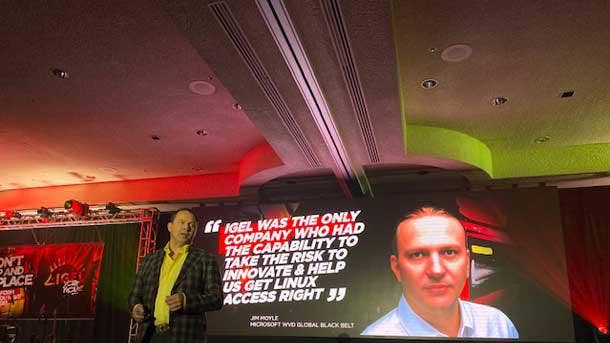
The ‘Audacious’ $1 Billion Sales Goal
When you think about IGEL and where we are headed we are a $150 million company today. We have an audacious goal that is still consistent with what (IGEL Co-CEO) Heiko (Gloge) said we want to the operating system for these cloud workspaces. We think we can be a $1 billion company and we think that looks like 10 million licenses. So when you think about the leaders in this space. When I started at IGEL (four years ago) IGEL was number seven in the US. We were noise… out at the end of the curve. We are now clearly number three. We are right on the tail of HP and Dell. We will move into the number one position in the coming year. You have to be selling over one million (licenses) to be the number one globally. We will pass one million. I will stand up here and tell you with all my friends here that we will become the number one player in this space.
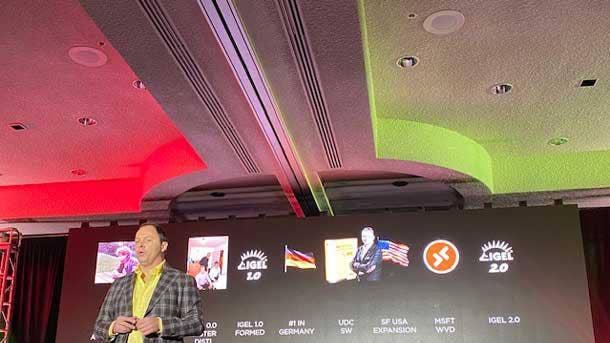
Savings Customers Big Money
"Why are we going to be able to sell one million seats? It is really simple. We help companies save money. We put 15,000, 20,000 and 30,000 devices back into use so they are not added to a landfill or have to be recycled. We also reduce the number of software things that are running on those devices because Linux simplifies the software stack. We drastically reduce the number of people managing those devices. We increase the security by reducing the attack vector of the operating system and probably most importantly make your end users happy- delivering them a technology that actually works with collaboration and printing. This is why IGEL is winning.
"We sold a very large fast-growing hospital in Texas on the last day of the year a 15,000 seat enterprise license agreement.
"I asked our rep how did we win this deal? He said I have a slide deck with two slides. This is the first slide out of the deck he showed (Security, Operational and Cost Benefits of IGEL). It is very simple. We are going to save them money, make them more secure, connect into ServiceNow, reduce some of the things that are point solutions around shadowing and sending messages to devices. Think about that times 15,000 seats. That is a lot of money. The second slide was the pure (numbers). You don’t have to go buy new HP hardware across 15,000 devices. We are going to save you $2.9 million. We got the order on the last day of the year. The sales rep was very happy when he got his paycheck. This is a great story and this is being repeated across the world. It is an amazing thing we are doing."
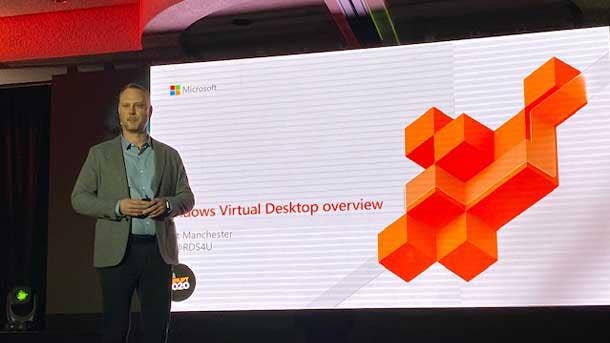
Disrupting The Cloud Desktop Market: Microsoft’s Windows Virtual Desktop
"I went out and Googled What is Windows 10? It was a fun exercise. It says the idea of Windows 10 is to unify the Windows experience across all devices from tablets to smartphones to computers and desktops. How are we going to do that? We are going to do it with the cloud. And we have this new guy running Microsoft – (Microsoft CEO Satya Nadella) who started in 2014 who ushered in this new era of Microsoft. I call it Microsoft 3.0. And in this new era he has an updated vision of the world. He stated on his first day as CEO of Microsoft – that this industry does not respect tradition. It respects innovation. Where is the innovation in today’s tech world coming from? It is coming from the cloud. Everything is going to be connected to the cloud and data and it is going to be intermediated by software. This vision has driven Microsoft stock up 300 percent. It is back as one of the most valuable companies in the world from $300 billion to nearly $1 trillion (under Satya Nadella). It is an amazing story of someone that has been unlocking the value of Microsoft with the cloud.
"A lot of that value can be attributed to Office(moving to the cloud). Taking Office – this tool that we all use everyday and putting it in Azure. Over the last five years we have gone from essentially zero people doing that to about 80 percent of the people in the enterprise consuming Office this way. This has been a big driver in the value of the stock. Step 2 for Microsoft is to put Windows in the Cloud. Windows Virtual Desktop is going to be the way we are going to do that."
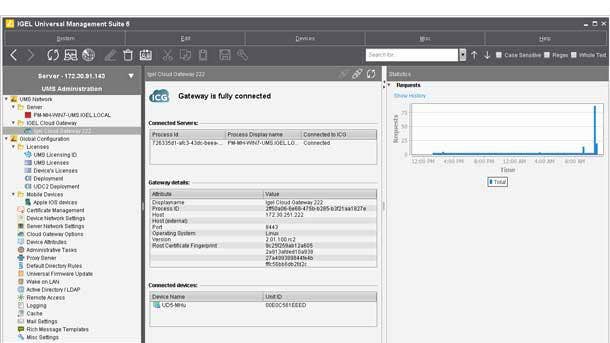
IGEL- The Next Generation Edge Operating System For Cloud Workspaces
"How do we describe ourselves today? It certainly isn’t as a thin client company. People ask me who is IGEL? By May of this year we came up with this- a next generation edge operating system for cloud workspaces. When I show this to customers they typically pull out their phone and say ‘Wow you finally articulated what I have been trying to tell my peers who this radical technology company is who is going to save us so much money.
"So when someone asks you who is IGEL? We would love for you to articulate that. This is who we are: a next generation edge operating system for cloud workspaces. What does that look like? It is a secure, highly manageable operating system that you can put on any x86 device that can work anywhere and connect to any protocol."

IGEL Software Sales Are Soaring
"In last four years we have doubled the business. The largest enterprises in the world across retail, healthcare, government , manufacturing are all agreeing with that sort of vision with where the world is going. The business has doubled. The number of seats that we sold has more than doubled. So we are headed toward one million seats being sold and activated every year from an IGEL operating system perspective. So what is the addressable market for this company. It is a very big addressable market. If you figure there are 100 million seats of virtualized workspace out there that is the market that we are helping – all the Citrix and VMware that constitutes that 100 million seats. So it is not the five million thin client market. It is really the 100 million seats of virtual workspace. And we are finding a more one to one correlation of IGEL licenses to Citrix and VMware. And of course we have one billion endpoints in the enterprise that are running x86. So there is a big attack surface for us to help you repurpose those devices to become secure, highly manageable, high performance devices in your virtual workspaces. What happens with Microsoft and Amazon getting into this space? We predict that at least 50 million more seats of virtual workspace can be sold in the next few years. This market has a lot of tailwinds behind it. It is very exciting. How do you spell the year of VDI? (Microsoft) WVD (Windows Virtual Desktop)."